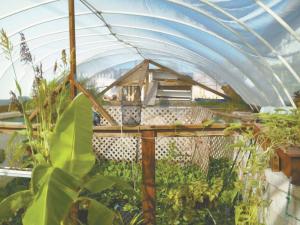2015 - Volume #39, Issue #3, Page #29
[ Sample Stories From This Issue | List of All Stories In This Issue | Print this story
| Read this issue]
He Grows Food In His Backyard Pool
 |
“When we bought our house, we loved the location and knew we wanted to grow food, but we had a limited space and budget,” McClung explains. A big area of the lot was taken up by a pool that required $10,000 of repairs. Instead, McClung turned it into a hoop house to create a greenhouse.
It quickly grew into much more than that. Tilapia fish grow in the deep end, which is filled with water. That water feeds into aquaponic growing beds and containers in the shallow end.
“The nice thing about the pool is the plaster walls. They make a wonderful pond and don’t throw off the pH. They are really built well, with a good inside structure that holds water,” McClung says.
Copying nature, he added pond plants such as duckweed to filter the water and feed ducks and chickens. The pond snails that came with the plants add calcium and help control pond sludge.
With only 9 in. of annual rain, water is precious, so the pool is also valuable as a containment system for water that drains off the house roof and carport.
“We capture over 10,000 gal. of water a year,” McClung says. In addition to the vegetables, he grows more than 40 fruit trees, including bananas, on his city lot.
Since he started with the hoop house in 2009, McClung has continually added to his miniature self-sufficient ecosystem, which includes solar power, water conservation and thermal mass protection from the coldest days in winter. He grows about 40 percent of the family’s food, including sweetener from sugar cane and milk from dairy goats.
When others noticed, he started sharing his ideas and gradually built up a network of 1,200 people who show up in groups of 40 to 60 to set up growing systems for members. McClung started a nonprofit called Garden Pool, with the mission of continuing research and education, into home grown food with ponds. “The pond is important because that’s where all the nutrients are produced. That’s where the rain water is stored,” McClung says.
For people interested in setting up their own systems, he suggests checking out the resources and viewing videos on the Garden Pool website and YouTube. McClung also designs systems for customers and shares many of his ideas in a book, “The Garden Pool”, available for $40.
Contact: FARM SHOW Followup, Garden Pool, Dennis McClung, 1605 W. 7th Place, Mesa, Ariz. 85201 (ph 480 532-5821; www.gardenpool.org).

Click here to download page story appeared in.

Click here to read entire issue
To read the rest of this story, download this issue below or click here to register with your account number.




